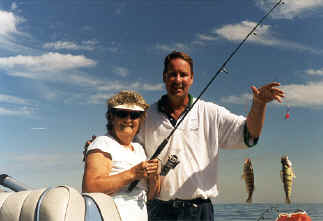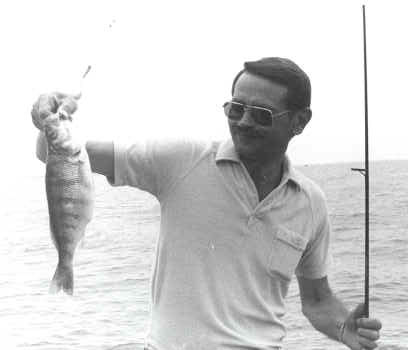
Lake Erie's Summer Perch
by
Richard Martin
Many anglers that visit Lake Erie restrict their yellow perch trips to early spring and mid-f all, and they catch fish. But summer action can be good too, as plenty of old proí s have discovered, so long as they keep in mind that summer fishing is just a little different.
This summer those who sink a shiner are going to find that perch action can
be absolutely excellent. According to Division of Wildlife studies populations
have had recruitment from several good year classes, and the Great Lakes Council
has seen fit to assign approximately the same lake-wide limit on sport and
commercial fishing as last year. Since last seasons fishing was top notch, this
year should see plenty of limit catches.
Yellow perch have always been a favorite fish in Lake Erie, because there are plenty of them, theyíre easy to catch, and crisp fried perch fillets are as good as youíre likely to taste. But it wasnít always that way. In the 1800ís they were considered trash fish, and one writer in 1877 said, "Its flesh is soft, rather coarse, and insipid, and at best it is nothing more than a third rate panfish. Makes you wonder how those old timers cooked them.
Pier fishing is one way to take some perch, but itís a little tougher in summer. In early spring theyíre in close for spawning activities, and come fall they tend to range closer to the piers and beaches, too. But in summer many schools are several miles offshore, and pier anglers who follow Standard Operating Procedure can find action slow.
Still, many perch schools will migrate on a daily basis, moving in close just at dawn to forage over clam beds, gravel bars, and rocky areas for minnows, insects, crayfish and other provender, then gradually swim back to deep water. Come evening, some will return, forage again until dark or after, and then head out again. So pier anglers are advised to be there at first crack of dawn or not far from dusk, because most of the day will provide slim pickings.
Lots of pier anglers use spreaders too, and theyíre just not a good idea. Casting out from a pier means the spreaders will be lying flat on bottom with their emerald shiners in the mud, not highly visible to feeding perch. Fishing with two smelled hooks about a foot apart above a sinker works much better. Not only is the sensitivity much better, since a biting perch can move a flat lying spreader around a good bit before registering a bite, but on short to modest casts at least one bait should be above the bottom and easily seen.
 Keep
in mind a general rule for pier fishing too, which is that the further out you
walk, the better catches usually are. At the highly popular Huron Pier in
downtown Huron, for example, those who walk clear to the end usually take most
of that days catch. Other popular piers in the Western Basin include the Catawba
State Park pier near the tip of Catawba Island, Marzak and Dempsey Access around
Marblehead, the South Bass State Park pier, and others further west, and east
from Cleveland to Ashtabula.
Keep
in mind a general rule for pier fishing too, which is that the further out you
walk, the better catches usually are. At the highly popular Huron Pier in
downtown Huron, for example, those who walk clear to the end usually take most
of that days catch. Other popular piers in the Western Basin include the Catawba
State Park pier near the tip of Catawba Island, Marzak and Dempsey Access around
Marblehead, the South Bass State Park pier, and others further west, and east
from Cleveland to Ashtabula.
Boat fishermen in the Western Basin enjoy excellent success in summer, and they do it in one of several ways. The easiest method is to head forth from a marina or public launch ramp, and just cruise looking for concentrations of boats. Then join those boats and fish. Chances are good that theyíre floating above a school and catching perch.
But itís never good to head right for the middle of a pack unless you see fish being pulled here and there in the center. At a clusterís outside edge youíll have first crack at any arriving schools, especially if you fish a while and move, fish a bit then move again, until rod tips start bouncing steadily. Summer schools of perch can be fairly tight, and itís not unusual to see one boat pulling fish while another just 50 feet away is catching nothing. Sitting over sterile water isnít the way to build quick limits.
Another method, often much better, is to find your own school by cruising slowly along and watching a fish locator for clusters of blips on the bottom. Then toss over a marker buoy, ease around upwind and drift down before you gently drop an anchor. Even here, action can be fast for a while, then a school moves on and isnít down there anymore. if action stops, itís time to fire up the fish locator and search again.
Lacking a fish locator and given a gentle wind, smart anglers will drift along with sinkers bumping bottom until a few bites turn up, then anchor and fish until catches end. If winds are strong, itís best to anchor and fish 15 minutes, then move and move some more until a school is found. Again, it just isnít wise to stop at random and fish there all day hoping something will come by.
Boat anglers can get by with spreaders, especially when biting is hot and heavy, but even here two snelled hooks above a sinker will produce best. The wire arms of a spreader wonít register a gentle bite, while the nearly straight down snells will sense the lightest touch. Last summer I took a headboat trip out of Port Clinton, found the fish finicky and action slow. At trips end only three people had a limit, two others, and myself and all were using a two hook rig. The others were fishing spreaders.
Top spots to go for that boating jaunt are plentiful in the Western Basin. Country off Cedar Point is a traditional hotspot, as is water around the Marblehead Lighthouse. Off the northwest corner of Kelleys Island is a good place, as is the north side of Rattlesnake, around Starve Island and Mouse Island, and more. Seek and ye shall find.
In the Central Basin fish run larger, but are fewer and harder to find. Sometimes perch will be in close here, but often enough they will be miles offshore holding over reefs or under random clouds of bait. So, a fish locator is vital. And sometimes theyíre hard to entice to a hook. One old charter captain I fished with had an answer for that.
Weíd find a school and if nothing much happened, he'd have the clients bait hooks with 6-8 dead minnows, lower them to bottom, and jerk hard! The sudden arrival (chumming) of lots of minnows often started them hitting, and once a few were hooked, they stirred up others and limits came quickly. An ancient trick, but it worked wonders, and itíll work for you.
Wherever you go for summer fishing, the rules are still simple. Find the fish, use proper gear, and when biting stops, move elsewhere and try again. Itís a formula that will provide some excellent eating this summer.